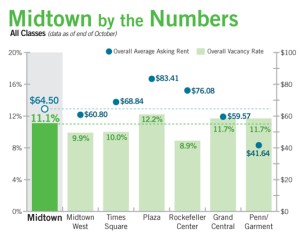Will the Midtown light shine brighter (it has been rather dim lately) since it escaped much of the wrath of post-tropical storm Sandy?
The jury, of course, is still out, but let’s review the facts: flooding and power outage issues continue in the southern third of Manhattan, but I most definitely think this part of the borough will come back.

Midtown, however, doesn’t always escape difficulty. Can you say West 57th Street crane debacle? Or the tourist-versus-tenant scuffle that occurs daily in Times Square? And don’t we all recall the blackout that darkened the entire area back in 2003? Or how about the old-fashioned financial services meltdown still affecting this submarket and causing the overall vacancy rate to hold today at a rather steep (by Midtown standards) 11.1 percent, above its quarterly average of 10.8 percent going back to 1991?
And how will Hudson Yards affect the heart of Midtown? And what about that East Midtown rezoning—will it happen? And if so, will it make a major difference? Does it appear as if I have more questions than answers?
It certainly seems that Midtown needs a kick in the pants as it continues to find its footing—especially for the top-tier segment. With financial services cutting back (and that industry being the primary tenant in the area), its Class A vacancy hovers well above 10 percent (closing October at 10.9 percent, above its historical quarterly average of 10 percent). In fact, the Class A Midtown segment continues to record negative absorption—the worst of any submarket or class segment in Manhattan. This is where the financial services industry was hunkered down and remains for the most part today—especially within the submarkets of Plaza, Rockefeller Center and Times Square.
But all is not negative—Class B and even Class C have held up Midtown recently, as TAMI firms (you may recall—technology/advertising/media/information) filter into pockets of Grand Central and Penn/Garment looking for less expensive alternatives to Midtown South. Barring a TAMI implosion (which there seems little chance of), this scenario will likely continue to play out. Some semblance of financial services recovery will most definitely begin to happen—it may be a while, and it’s unclear what form it might take. But until then, Midtown, the former bright star of the American office market, will continue to just plod along.
Robert Sammons, Cassidy Turley


